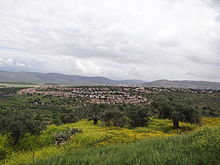


A community settlement (Hebrew: יישוב קהילתי, Yishuv Kehilati) is a type of town or village in Israel and in the West Bank. In an ordinary town, anyone may buy property, but in a community settlement, the village's residents are organized in a cooperative and have the power to approve or to veto a sale of a house or a business to any buyer. Residents of a community settlement may have a particular shared ideology, religious perspective or desired lifestyle, which they wish to perpetuate by accepting only like-minded individuals. For example, a family-oriented community settlement that wishes to avoid becoming a retirement community may choose to accept only young married couples as new residents.
As distinct from the traditional Israeli development village, typified by the kibbutz and moshav, the community settlement emerged in the 1970s as a non-political movement for new urban settlements in Israel.[1] However, it essentially took shape as a new typology for settling the West Bank and the Galilee as part of the goal of establishing a "demographic balance" between Jews and Arabs.[2] In practice, that means establishing Jewish-only settlements, which have the right to refuse Arabs from moving to them. Israeli courts have approved the policy in its ruling as well. The law explicitly prohibits explicit discrimination against members of other social groups, but it permits the admissions committees to reject candidates on such vague grounds as "unsuitability to the community's social life" or its "social-cultural fabric" or to "unique characteristics of the community as defined in its bylaws."[3] Human rights organizations argue that the law could still enable communities to discriminate against individuals based on factors such as sexual orientation, disability, or ethnicity, contravening both Israeli and international legal standards against discrimination.[3]
In 2013, there were 118 community settlements with total population of 84,800 residents.[4]
- ^ Aharon Kellerman, Society and Settlement: Jewish Land of Israel in the Twentieth Century, SUNY Press 2012 pp.94-102.
- ^ Cite error: The named reference
Weizmanwas invoked but never defined (see the help page). - ^ a b "High Court Upholds Residential Screening Law, Enabling Jewish Villages to Keep Arabs Out". Haaretz.
- ^ "Localities and population, by type of localitiy and population group" (PDF).